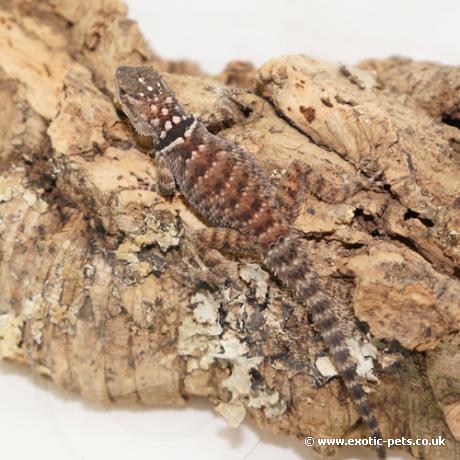

The Blue Spiny Swift is also known as a Blue Fence Lizard, males have a blue under belly when breeding. They inhabit deserts, shrub lands and rocky hillsides from Texas to Mexico.
| Origin | Texas and Mexico |
|---|---|
| Environment | Rocky Outcrops |
| Adult Size | 35cm |
| Suitability | Novice |
| Life Span | 8 Years + |
| Temperament | Skittish |
This lizard has a typical swift appearance with large, pointy and ridged scales. The overall colour is grey with a black band across the neck. White spots are present around the head and neck area that start to fade as they travel down the body. Males can be distinguished as they tend to have a metallic green or blue on the back; during the breeding season they have a blue throat and underbelly. Young animals and females lack this colouration.
They are one of the largest species of swifts; males reach a total length of 35cm whereas females are slightly smaller at 25cm. Females are live bearing (ovoviviparous) giving birth to between 6-15 young.
They can be found living in arid and semi-arid environments of Texas to Mexico. Preferring to live within rocky terrains, they are mainly found basking on large boulders and running within rock crevasses.
This is an active species therefore a large spacious enclosure is required. To keep a trio of Blue Spiny Swifts a minimum vivarium size of 4x2x2ft should be provided, this will allow some height for climbing.
Being native to Mexico and Texas, they like the sun and heat; provide an ambient day time temperature of 28-30C (82-86F) with a basking area of 40-45C (104-113F). Allow a night time temperature drop down to 18-22C (64-72F). We would recommend using a 10% output of UVB or a mercury vapour bulb; this will give a high basking area along with a high UVB.
The vivarium should have plenty of rocks, hides and even branches to allow climbing, with some foliage. A sand/soil mix works well as this would be their natural substrate. A small water dish should always be available and changed daily.
Feed on a varied diet of insects; crickets, locusts and mealworms are taken readily. Ensure these are gut loaded before each feed and these have been dusted with vitamin/mineral supplements as directed. Young animals should be fed every day on as many as they will take in one sitting; as they mature to adults lower the feeds to 3-4 times a week again with as many as they will take in one sitting.